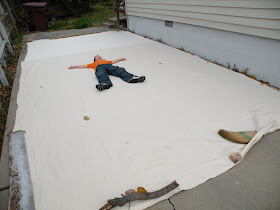Without a doubt the most daunting part of planning my tipi cover has been the lift pole/smoke flap assembly. This is were the real part of making a lodge is. The fact that my cover is made of lightweight canvas means I have to constantly think about reinforcing, reinforcing, reinforcing. The last thing I want to do is set up my lodge and have the first strong gust that catches the fabric to result in a catastrophy!
My tipi's lift flap will have 4 layers - 1 triangular piece on top the cover, with those sandwiched between two large half-circle patches above and below. The reinfored stitching over this area will be done in a criss-cross, or quilt-style pattern. Also, these patches extend over the adjoining corners of the smoke flaps which will be reinforced with a folded strip exteding up to the pole pockets. All along the edge, from pole pocket to lift flap to pole pocket will be adde a hem of 3" webbing tape.
I had to stop work for a few days until I could find a place that sold canvas sewing machine needles after the Sears Kenmore finally busted one after all this time. I learned that no matter how carefully I try, this machine will not zig-zag stitch through more than two-three layers of canvas fabric without catching the needle. Zig zags are stronger than straight stitches (ask sail-makers) but there's only so much that I can ask Grandma's old sewing machine to do.
I also had to run out and buy a third section of canvas now that I'll be extending the pin-hole flaps outward from the cover body due to adding gore panels to the bases of my smoke flaps. One little change can effect everything!
 Only after it starts to get real cold do we see the Dark Eyed Junco around this neck of the prairies. There were several feeding together today.
Only after it starts to get real cold do we see the Dark Eyed Junco around this neck of the prairies. There were several feeding together today. A hungry Black-Capped Chickadee cracking open a sunflower seed. He has to hold it between both feet and hammer away with his beak, feeding is a lot of work!
A hungry Black-Capped Chickadee cracking open a sunflower seed. He has to hold it between both feet and hammer away with his beak, feeding is a lot of work! This clinging bit of Big Sagebrush looks all alone. Last year's unforgiving winter snuffed out all of the other hardy shrubs but this.
This clinging bit of Big Sagebrush looks all alone. Last year's unforgiving winter snuffed out all of the other hardy shrubs but this.













































